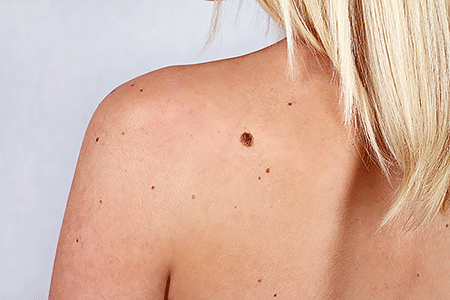How can I tell if I have skin cancer?
Skin cancer is actually one of the easiest cancers to find. That’s because skin cancer usually begins where you can see it.
You can get skin cancer anywhere on your skin — from your scalp to the bottoms of your feet. Even if the area gets little sun, it’s possible for skin cancer to develop there.
You can also get skin cancer in places that may surprise you. Skin cancer can begin under a toenail or fingernail, on your genitals, inside your mouth, or on a lip.
You can find skin cancer on your body
The best way to find skin cancer is to examine yourself. When checking, you want to look at the spots on your skin. And you want to check everywhere — from your scalp (parting your hair to check your entire scalp) to the spaces between your toes and the bottoms of your feet.
If possible, having a partner can be helpful. Your partner can examine hard-to-see areas like your scalp and back.
Getting in the habit of checking your skin will help you notice changes. Checking monthly can be beneficial. If you have had skin cancer, your dermatologist can tell you how often you should check your skin.
People of all ages get skin cancer
Checking your skin can help you find skin cancer early when it’s highly treatable.

What skin cancer looks like
Skin cancer appears on the body in many different ways. It can look like a:
Changing mole or mole that looks different from your others
Dome-shaped growth
Scaly patch
Non-healing sore or sore that heals and returns
Brown or black streak under a nail
It can also show up in other ways.
To find skin cancer on your body, you don’t have to remember a long list. Dermatologists sum it up this way. It’s time to see a dermatologist if you notice a spot on your skin that:
Differs from the others
Changes
Itches
Bleeds
To make it easy for you to check your skin, the AAD created the Body Mole Map. You’ll find everything you need to know on a single page. Illustrations show you how to examine your skin and what to look for. There’s even place to record what your spots look like. You’ll find this page, which you can print, at Body Mole Map.
You can feel well and still have skin cancer
Most people who find a suspicious spot on their skin or streak beneath a nail feel fine. They don’t have any pain. They don’t feel ill. The only difference they notice is the suspicious-looking spot. That spot doesn’t have to itch, bleed, or feel painful. Although, skin cancer sometimes does.
See a suspicious spot, see a dermatologist
If you find a spot on your skin that could be skin cancer, it’s time to see a dermatologist. Found early, skin cancer is highly treatable. Often a dermatologist can treat an early skin cancer by removing the cancer and a bit of normal-looking skin.
Given time to grow, treatment for skin cancer becomes more difficult.
Skin cancer diagnosis always requires a skin biopsy
When you see a dermatologist because you’ve found a spot that might be skin cancer, your dermatologist will examine the spot.
If the spot looks like it could be a skin cancer, your dermatologist will remove it all or part of it. This can easily be done during your appointment. The procedure that your dermatologist uses to remove the spot is called a skin biopsy.
Having a skin biopsy is essential. It’s the only way to know whether you have skin cancer. There’s no other way to know for sure.
What your dermatologist removes will be looked at under a microscope. The doctor who examines the removed skin will look for cancer cells. If cancer cells are found, your biopsy report will tell you what type of skin cancer cells were found. When cancer cells aren’t found, your biopsy report will explain what was seen under the microscope.
How to find a dermatologist
If you find a suspicious spot, seeing a dermatologist can give you peace of mind. Dermatologists are experts in caring for the skin and have more experience diagnosing skin cancer than any other doctor.
You can find a dermatologist by going to, Find a dermatologist.
Related AAD resources
Image
References
Bichakjian CK, Halpern AC, et al. “Guidelines of care for the management of primary cutaneous melanoma.” J Am Acad Dermatol. 2011 Nov;65(5):1032-47.
Garg A, Levin NA, et al. “Approach to dermatologic diagnosis.” In: Wolff K, Goldsmith LA, et al. Fitzpatrick’s Dermatology in General Medicine (seventh edition). McGraw Hill Medical, New York, 2008: 25.
 Atopic dermatitis: More FDA-approved treatments
Atopic dermatitis: More FDA-approved treatments
 Biosimilars: 14 FAQs
Biosimilars: 14 FAQs
 How to trim your nails
How to trim your nails
 Relieve uncontrollably itchy skin
Relieve uncontrollably itchy skin
 Fade dark spots
Fade dark spots
 Untreatable razor bumps or acne?
Untreatable razor bumps or acne?
 Tattoo removal
Tattoo removal
 Scar treatment
Scar treatment
 Free materials to help raise skin cancer awareness
Free materials to help raise skin cancer awareness
 Dermatologist-approved lesson plans, activities you can use
Dermatologist-approved lesson plans, activities you can use
 Find a Dermatologist
Find a Dermatologist
 What is a dermatologist?
What is a dermatologist?